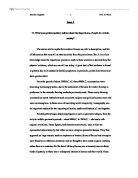Pre-Archaic art and the continuance of the most part of its style through the Archaic period gives us much insight into the Greek sense of proportion. As with the way that they built their structures and temples, the figures are geometrically sound, but this in itself makes them unlifelike and not a ‘natural’ representation. The Archaic period shows ‘naturalism’ creeping into Greek art, with a heavy influence from Oriental art. Animals and monsters become more frequently seen, and rosettes and dots form a background, something seen most often in Eastern textiles. It is these early steps towards attempting a true resemblance of the subject that are characteristic of the Archaic. Figures are still largely geometrically sound, with set geometry for the curves of the face, the placing of the nose and height of the ears and so forth, but there are subtle departures from the geometric perfection, which in their inaccuracy to the ‘perfection’, instil an essence of ‘life’ and naturalism to the images. For example; “An artist of this period cannot master all the torsions and tensions, the projections and cavities which real objects present, but confines himself to a simple standard appearance from a single and favourable point of view.” 1
The over-refinement of form leads to an over simplicity which will not tolerate any deviation from geometric perfection. The breaking down of this barrier is what charectarises the Archaic period, the first tentative steps to true representation. It is quite amusing to wonder how an Archaic artist would have attempted to portray a scar. Would he have assumed that it would be more accurate to draw the scar so that it bisected the curve of the cheek at precisely 45 degrees or tried to make it as true to life as possible? That we have evidence of both representations from that period is proof of the traits of the Archaic artist.
Classical art shows much of the naturalistic tendencies of Archaic art advanced to the forefront of the artwork. The society has changed, and so the imagery of their art is different also. Athens has become a model of excellence for the rest of Greece. There is more of a freedom to enjoy the luxuries of life and society accepts indulgence as not softness but success. The role of the Gods has changed and they are no longer invoked in the same way as before. For example, The goddess Aphrodite ceased to be a representation of fertility and instead became the goddess of carnal love. Powerful male gods such as Hermes are pictured displaying human traits such as holding an infant in their arms. It is a relief of the restrictions, men are not always shown in rigid stance with a clenched fist and left foot forward (a stance heavily drawn from the Egyptian styles of drawing), but are pictured naked and relaxing. It is a time of decadence for the rich, and so it is understandable that this would be reflected in the cup that they drink from, their human traits would be conferred upon the gods they immortalise. The most obvious examples of this are found in Greek sculpture. To strive to create a truly lifelike sculpture is a tremendous task as we as people see the human form every day. To confer this to stone and have it stand up to close scrutiny is almost impossible. Here is where another of the key themes of the classical period is revealed. The Greek attitude to much sculpture was not to create a true image of a person, but to represent the person as it would seem to someone who had quickly glanced at them, or saw them whilst under some sort of emotional stress. It is this bias in the creation of the object that is akin to emotional expression.
“Although nature was always the check and the corrective, the sculptor was not aiming at reproducing her chance individual appearances. He did not imitate the casual, but the underlying permanence. His statues were not intended for replicas of unusually beautiful persons in unusually attractive attitudes. He did not make men as they appeared, but in the deepest philosophical sense, men as they were in their essence.”
It is no coincidence that the greatest achievement of technically realistic art is also at the height of the society’s decadence. Art follows the real world and so a society in which the pursuit of pleasure of the senses is acceptable, then the ascent of art is almost guaranteed.
Bibliography
Anna A Lemos, Archaic Pottery of Chios: The Decorated Styles, Oxford; Oxford University Committee For Archaeology, 1991
John Boardman, Athenian Red Figure Vases: The Archaic Period: A Handbook, London: Thomas & Hudson, 1975
Robin Osborne, Archaic and Classical Greek Art, Oxford; New York: Oxford University Press, 1998







